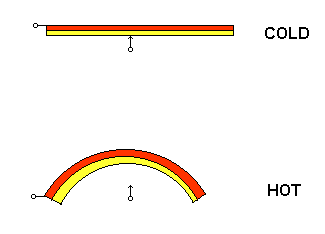| When an object is heated
above the temperature of its surroundings it will lose heat to the surroundings.
Heat is transferred in three
ways.
1. CONDUCTION
If one end of a metal bar
is heated then heat is transferred by conduction to the cold end.
Good electrical conductors
such as copper and gold are good conductors of heat.
Poor electrical conductors,
such as wood and paper, are poor heat conductors.
Heat can be conducted between
two objects if they are in close contact.
For example between a soldering
iron and a soldering terminal; or between a power transistor and its heatsink.
2. CONVECTION
Here, heat is transferred
by the movement of a gas or a liquid.
Hot air rises and cold air
falls. Liquids behave in a similar manner.
A hot resistor causes convection,
transferring heat from the resistor to the surrounding air.
Hot water in a pan rises
to the top while the cold water falls to the bottom.
These movements are called
convection currents (nothing to do with electric currents).
The above process is called
NATURAL CONVECTION.
If a fan is used to aid
convection it is called FORCED CONVECTION.
3. RADIATION
This does not need a gas
or liquid to transfer the heat.
Heat is expelled mostly
in the form of infrared radiation.
This is a form of light
and travels at the speed of light.
It can travel through a
vacuum.
This is why we can feel
the heat of the sun even though it has to travel through the vacuum of
space to reach earth.
Polished surfaces are poor
radiators but good reflectors of heat. That is why electric fires have
shiny reflectors.
Black objects are good radiators.
THE EFFECTS OF HEAT
Heat causes solid objects
to expand.
That is why they have gaps
in railway lines and bridges to allow for summertime temperatures.
Different metals expand at
different rates.
A temperature switch can
be made from two strips of disimilar metals fixed together.
As the temperature increases,
one strip grows longer than the other, causing the strips to curve. This
in turn breaks (or makes) a circuit.
 Increasing temperatures also
cause liquids to expand. This behaviour is used in the thermometer.
Increasing temperatures also
cause liquids to expand. This behaviour is used in the thermometer.
Gases also expand with temperature
increases.
HEAT AND ELECTRONICS
Heat is one of the biggest
enemies of electronics, causing components to fail.
To minimise the effects
some action can be taken.
Increasing the surface area
increase convection and radiation. High wattages resistors are larger than
low wattage ones.
Using holes and louvres
in the casing increases natural convection.
Using fans provides forced
convection.
Using heat sinks with fins
increases surface area thus providing increased convection and radiation.
Painting heat sinks blacks
increases radiation.
Using "heat sink compound",
which is a good conductor, between transistors and their heatsinks, improves
heat conduction.
Fitting components onto
the metal chassis aids the dissipation of heat. |

